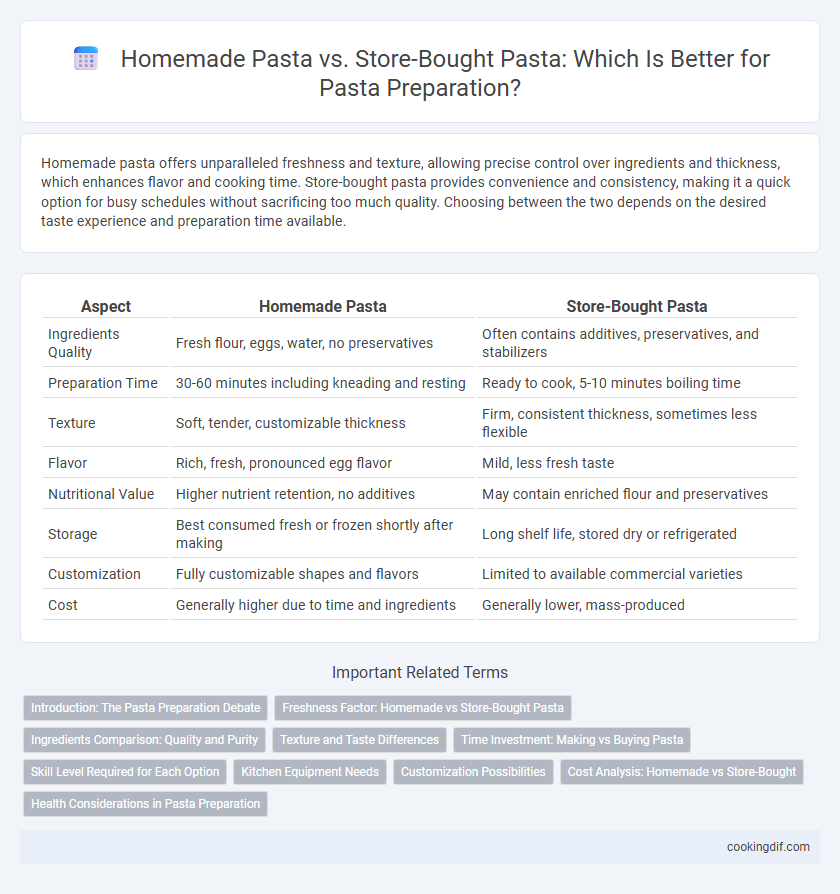Homemade pasta offers unparalleled freshness and texture, allowing precise control over ingredients and thickness, which enhances flavor and cooking time. Store-bought pasta provides convenience and consistency, making it a quick option for busy schedules without sacrificing too much quality. Choosing between the two depends on the desired taste experience and preparation time available.
Table of Comparison
| Aspect | Homemade Pasta | Store-Bought Pasta |
|---|---|---|
| Ingredients Quality | Fresh flour, eggs, water, no preservatives | Often contains additives, preservatives, and stabilizers |
| Preparation Time | 30-60 minutes including kneading and resting | Ready to cook, 5-10 minutes boiling time |
| Texture | Soft, tender, customizable thickness | Firm, consistent thickness, sometimes less flexible |
| Flavor | Rich, fresh, pronounced egg flavor | Mild, less fresh taste |
| Nutritional Value | Higher nutrient retention, no additives | May contain enriched flour and preservatives |
| Storage | Best consumed fresh or frozen shortly after making | Long shelf life, stored dry or refrigerated |
| Customization | Fully customizable shapes and flavors | Limited to available commercial varieties |
| Cost | Generally higher due to time and ingredients | Generally lower, mass-produced |
Introduction: The Pasta Preparation Debate
Homemade pasta offers a fresh texture and customizable ingredients, allowing chefs to control flour type, thickness, and shapes, resulting in a richer culinary experience. Store-bought pasta provides convenience and consistency with standardized shapes and drying methods, making it ideal for quick meal preparation. The debate centers on balancing freshness and control against time efficiency and shelf stability.
Freshness Factor: Homemade vs Store-Bought Pasta
Homemade pasta offers superior freshness due to its immediate preparation and lack of preservatives, resulting in a tender texture and richer flavor profile. Store-bought pasta, while convenient, often contains additives to extend shelf life, which can compromise texture and taste. Freshness in homemade pasta enhances sauce absorption and overall culinary experience, making it a preferred choice for authentic Italian dishes.
Ingredients Comparison: Quality and Purity
Homemade pasta typically features higher quality ingredients like fresh eggs and finely milled flour, ensuring purity without preservatives or additives commonly found in store-bought pasta. Store-bought pasta often contains durum wheat semolina with added stabilizers and may lack the rich flavor and texture derived from fresh, natural components. Choosing homemade pasta guarantees control over ingredient quality, resulting in a more authentic and nutritious dish.
Texture and Taste Differences
Homemade pasta offers a delicate, tender texture with a superior chewiness compared to store-bought pasta, which often has a denser and firmer bite due to drying processes. The fresh ingredients in homemade pasta enhance flavor complexity, delivering a rich, eggy taste that store-bought varieties typically lack. Variations in flour types and hydration during homemade preparation also contribute significantly to its unique mouthfeel and aromatic profile.
Time Investment: Making vs Buying Pasta
Homemade pasta requires a time investment of 60 to 90 minutes, including mixing, kneading, resting, and rolling the dough, while store-bought pasta offers convenience with immediate preparation and cooking times ranging from 8 to 12 minutes. The process of making fresh pasta enhances texture and flavor but demands skill and patience compared to the quick and consistent results from dried or fresh store-bought options. Choosing between homemade and store-bought pasta depends on balancing the desire for artisanal quality against the need for time efficiency in meal preparation.
Skill Level Required for Each Option
Homemade pasta requires a higher skill level, including mastering dough consistency, rolling techniques, and proper cutting to achieve the desired texture and thickness. Store-bought pasta offers convenience with consistent quality and minimal preparation, ideal for beginners or quick meals. Skilled cooks often prefer homemade pasta for its customizable flavors and superior texture, despite the longer preparation time.
Kitchen Equipment Needs
Homemade pasta requires specific kitchen equipment such as a pasta machine or rolling pin, a mixing bowl, and a sharp knife or pasta cutter to achieve the desired texture and thickness. Store-bought pasta eliminates the need for these tools, offering convenience with ready-to-cook consistency and uniform shapes. Using homemade versus store-bought pasta significantly impacts preparation time and the variety of shapes achievable in the kitchen.
Customization Possibilities
Homemade pasta offers extensive customization possibilities, allowing control over ingredients such as flour type, egg ratio, and flavor infusions like herbs or spices, which store-bought pasta lacks. Textural variations and thickness can be precisely tailored in homemade pasta to suit specific recipes, enhancing the overall culinary experience. Store-bought pasta provides convenience but generally limits personalization to predefined shapes and compositions, restricting creativity in preparation.
Cost Analysis: Homemade vs Store-Bought
Homemade pasta requires basic ingredients like flour and eggs, often resulting in a lower cost per serving compared to store-bought pasta, which includes packaging and brand pricing. While homemade pasta entails time and skill investment, it offers customization options and freshness that can justify initial effort. Store-bought pasta provides convenience with consistent quality but may lead to higher cumulative expenses, especially for premium or specialty varieties.
Health Considerations in Pasta Preparation
Homemade pasta allows precise control over ingredients, enabling the use of whole grains, organic flour, and less salt, which enhances nutritional value and reduces additives common in store-bought varieties. Store-bought pasta often contains preservatives and may have a higher glycemic index due to refined flours, potentially impacting blood sugar levels. Opting for homemade pasta supports healthier preparation methods by minimizing processed components and customizing portion sizes to balance carbohydrate intake effectively.
Homemade pasta vs store-bought pasta for preparation Infographic

 cookingdif.com
cookingdif.com